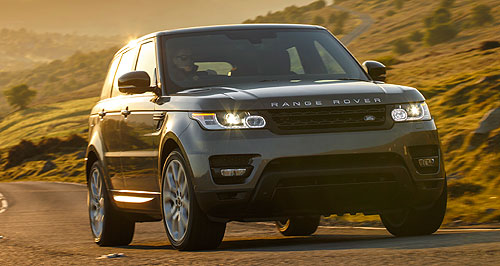Make / Model Search
Future models - Land Rover - Range RoverLCT limbo-dance for Range Rover, SportFrugal new diesel heralds Luxury Car Tax advantage for Range Rover and Rangie Sport6 Nov 2014 AUSTRALIAN Range Rover and Range Rover Sport buyers will get access to extra technology from March, including a more fuel-efficient TDV6 entry-level engine that could save customers more than $4000 in Luxury Car Tax (LCT). The ‘model year 15.5’ update also comprises an off-road cruise control system, a head-up display, more power and torque from the SDV6 diesel engine, improved efficiency from the SCV6 petrol engine and some new colour combinations. Land Rover Australia is yet to determine pricing for the revised models and whether it will pass on a cash LCT saving to customers or include more standard equipment on TDV6-powered Range Rover and Range Rover Sport models that now consume 6.9 litres of diesel per 100 kilometres. If a car uses less than 7.0L/100km, the LCT threshold is raised from $60,316 to $75,375, meaning the least expensive Range Rover Sport, the new TDV6 S range-opener introduced last month, could decrease from $92,600 plus on-road costs to around $88,550. That would make the six-cylinder Rangie Sport S $350 less expensive than the four-cylinder, four-wheel-drive BMW X5 xDrive25d (the rear-drive sDrive25d is $83,900) and $5050 more expensive than the $83,500 Mercedes-Benz ML250, which also uses a four-cylinder engine. For the revised TDV6, Land Rover has replaced twin turbos with a single ball-bearing unit, added low pressure exhaust gas recirculation, updated the fuel injector design and fitted a two-stage oil pump that reduces drag on the engine. Outputs remain at 190kW and 600Nm but the changes yield a 5.7 per cent fuel saving on the Range Rover Sport and 8.6 per cent on the flagship Range Rover, both of which consume 6.9L/100km with the updated engine – not far off the 6.4L/100km figure of the Range Rover Sport SDV6 Hybrid introduced last month and priced from $146,900. For comparison the BMW’s engine is a litre smaller than the Range Rover’s, producing 160kW and 450Nm, returning 5.9L/100km in rear-drive form or 6.0L/100km as a four-wheel-drive and the 4WD-only Benz returns 6.4L/100km from its 150kW/500Nm 2.2-litre unit. Land Rover’s All-Terrain Progress Control (APTC) technology is similar in operation to the CRAWL system on up-spec Toyota LandCruiser Prados in that it allows the driver to take their feet off the pedals during challenging off-road situations and concentrate on steering while the electronics take charge of controlling vehicle speed and maintaining traction. When using APTC the driver can use the cruise control system to set a speed between 2km/h and 30km/h – in forward and reverse gears – at which to tackle steep, rough and low-grip terrain. No doubt destined to reach more Land Rover products in future, APTC will debut on all Range Rover and Sport variants except those fitted with the TDV6 engine, which in Australia are not offered with the requisite a dual-range transfer case or Terrain Response systems. From May the Australian delivered Range Rover and Sport will also debut Land Rover’s new head up display, which projects information like speed, sat-nav directions, cruise control settings and gear position, including a shift indicator for driving in manual mode. By retaining the parallel-sequential turbos and applying similar tweaks as on the TDV6, Land Rover has upped the power and torque of the Range Rover Sport’s gruntier SDV6 engine by 10kW and 100Nm respectively, resulting in peak outputs of 225kW and 700Nm yet reducing fuel use by 7.0 per cent to 7.0L/100km. The 3.0-litre supercharged petrol SCV6 engine also receives efficiency gains, with 1.9 per cent lower usage on the Range Rover and Sport (down to 10.5L/100km and 10.7/100km respectively) resulting from updated injectors, friction reduction measures and a new thermostat that enables it to more quickly reach operating temperature. New exterior paint finishes available on the MY15.5 Range Rover and Sport include Yulong (metallic white) and Kaikoura Stone (a metallic brown/gold) is offered on the Sport. In addition to the Range Rover Sport S price leader and hybrid variants introduced as part of the MY15 updates announced last month, Land Rover cut prices across the Sport range by between $400 and $500 while adding more than $6000 worth of extra equipment to SE, HSE and HSE Dynamic variants. The British off-road specialists also confirmed the rip-snorting 404kW/690Nm SVR – which claimed a production SUV Nurburgring lap time record of eight minutes and 14 seconds – will arrive in Australian showrooms next March, with prices announced closer to that time.  Read more23rd of October 2014  Jaguar Land Rover fires up Chinese factoryFirst “fully fledged” JLR factory in China set to make three models by 201620th of October 2014  New base variant for 2015 Range Rover SportThe 2015 Land Rover Range Rover Sport gets new base and hybrid variant20th of October 2014  First Land Rover Discovery Sport rolls off lineDiscovery Sport signals a new start for Land Rover and the British auto industry.3rd of October 2014  Paris show: Land Rover Discovery Sport revealedLand Rover dumps Freelander for all-new Discovery SportAll future modelsRange Rover pricing
Motor industry news |
Click to shareLand Rover modelsAll future modelsRange Rover pricing
Motor industry news |



 Alfa Romeo
Alfa Romeo Abarth
Abarth Audi
Audi Aston Martin
Aston Martin BMW
BMW Bentley
Bentley Ferrari
Ferrari Chevrolet
Chevrolet Ford
Ford Fiat
Fiat GWM
GWM Foton
Foton Hyundai
Hyundai Honda
Honda Jaguar
Jaguar Isuzu
Isuzu Kia
Kia Jeep
Jeep Land Rover
Land Rover Lamborghini
Lamborghini Maserati
Maserati Lexus
Lexus McLaren
McLaren Mazda
Mazda Mercedes-Benz
Mercedes-Benz Mitsubishi
Mitsubishi Mini
Mini Peugeot
Peugeot Nissan
Nissan Ram
Ram Porsche
Porsche Rolls-Royce
Rolls-Royce Smart
Smart Skoda
Skoda Suzuki
Suzuki Subaru
Subaru Toyota
Toyota Tesla
Tesla Volvo
Volvo Zeekr
Zeekr







Facebook Twitter Instagram